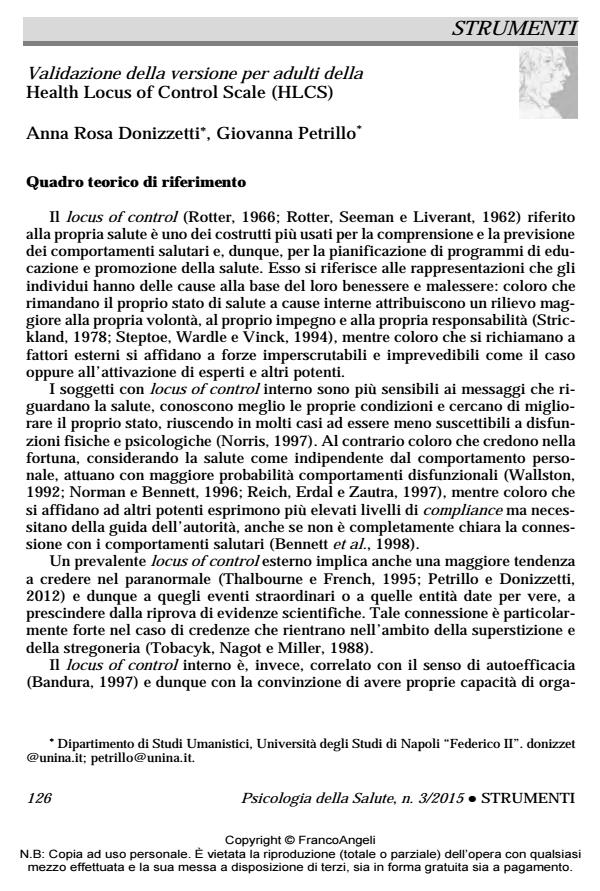Health Locus of Control Scale for adults: a validation study
Journal title PSICOLOGIA DELLA SALUTE
Author/s Anna Rosa Donizzetti, Giovanna Petrillo
Publishing Year 2015 Issue 2015/3
Language Italian Pages 17 P. 126-142 File size 220 KB
DOI 10.3280/PDS2015-003007
DOI is like a bar code for intellectual property: to have more infomation
click here
Below, you can see the article first page
If you want to buy this article in PDF format, you can do it, following the instructions to buy download credits

FrancoAngeli is member of Publishers International Linking Association, Inc (PILA), a not-for-profit association which run the CrossRef service enabling links to and from online scholarly content.
It is well-known in health psychology literature, that health locus of control is an important issue for understanding and predicting health behaviors, but the psychometric properties of the existing scales are not fully established. The aim of this study was to test the psychometric properties of the Health Locus of control Scale (HLCS) for adolescents by Donizzetti and Petrillo (2011), considering an adults population. 922 participants, equally distributed by gender (50.2% male), with a mean age of 52.2 years (SD = 20.20) were involved in the study. Confirmatory factor analysis highlighted a three-dimensional structure. In addition, correlational analyses have demonstrated the convergent and discriminant validity. The scale is invariant across gender. The adult version of HLCS consists of 13 items and resulted a valuable and reliable tool. Easy to administer, it can be used for purposes of research and intervention for the detection of beliefs about control of physical health in adult populations.
Keywords: Health locus of control; HLCS; Scale validation; Adults.
- Paranormal Health Beliefs: Relations Between Social Dominance Orientation and Mental Illness Donizzetti Anna Rosa, in The Open Psychology Journal /2018 pp.35
DOI: 10.2174/1874350101811010035 - The “Land of Fires” Toxic Waste Scandal and Its Effect on Consumer Food Choices Luigi Cembalo, Daniela Caso, Valentina Carfora, Francesco Caracciolo, Alessia Lombardi, Gianni Cicia, in International Journal of Environmental Research and Public Health /2019 pp.165
DOI: 10.3390/ijerph16010165 - University Student Mental Well-Being during COVID-19 Outbreak: What Are the Relationships between Information Seeking, Perceived Risk and Personal Resources Related to the Academic Context? Vincenza Capone, Daniela Caso, Anna Rosa Donizzetti, Fortuna Procentese, in Sustainability /2020 pp.7039
DOI: 10.3390/su12177039 - The Relation Between Maternal Locus of Control And Coping Styles of Pediatric Leukemia Patients During Treatment Concetta Polizzi, Giovanna Perricone, Valentina Fontana, Paolo D'Angelo, Momcilo Jankovic, Francesca Nichelli, Calogero Taormina, Sofia Burgio, in Pediatric Reports /2020 pp.7998
DOI: 10.4081/pr.2020.7998 - Behind the Scenes of COVID-19 Vaccine Hesitancy: Psychological Predictors in an Italian Community Sample Sofia Tagini, Agostino Brugnera, Roberta Ferrucci, Alberto Priori, Angelo Compare, Laura Parolin, Gabriella Pravettoni, Vincenzo Silani, Barbara Poletti, in Vaccines /2022 pp.1158
DOI: 10.3390/vaccines10071158 - Validation of the Paranormal Health Beliefs Scale for adults Anna Rosa Donizzetti, Giovanna Petrillo, in Health Psychology Open 2055102917748460/2017
DOI: 10.1177/2055102917748460 - Exploring emotions in dialog between health provider, parent and child. An observational study in pediatric primary care Francesca Dicé, Pasquale Dolce, Assunta Maiello, Maria Francesca Freda, in Pratiques Psychologiques /2020 pp.69
DOI: 10.1016/j.prps.2018.12.001 - Ageism in an Aging Society: The Role of Knowledge, Anxiety about Aging, and Stereotypes in Young People and Adults Anna Rosa Donizzetti, in International Journal of Environmental Research and Public Health /2019 pp.1329
DOI: 10.3390/ijerph16081329 - Attachment, Personality and Locus of Control: Psychological Determinants of Risk Perception and Preventive Behaviors for COVID-19 Sofia Tagini, Agostino Brugnera, Roberta Ferrucci, Ketti Mazzocco, Luca Pievani, Alberto Priori, Nicola Ticozzi, Angelo Compare, Vincenzo Silani, Gabriella Pravettoni, Barbara Poletti, in Frontiers in Psychology 634012/2021
DOI: 10.3389/fpsyg.2021.634012 - Facing the pandemic lockdown questionnaire - FPLQ: A brief tool to assess individual differences in front of pandemic experience Andrea Baroncelli, Lucrezia Tomberli, MariaGiulia Taddei, Enrica Ciucci, in Current Psychology /2023 pp.30635
DOI: 10.1007/s12144-022-02701-2
Anna Rosa Donizzetti, Giovanna Petrillo, Validazione della versione per adulti della Health Locus of Control Scale (HLCS) in "PSICOLOGIA DELLA SALUTE" 3/2015, pp 126-142, DOI: 10.3280/PDS2015-003007